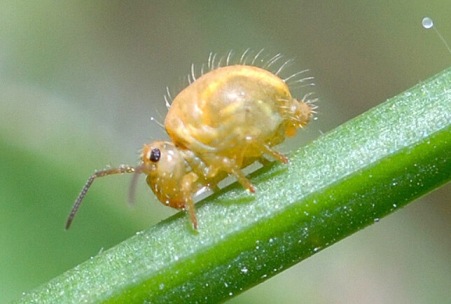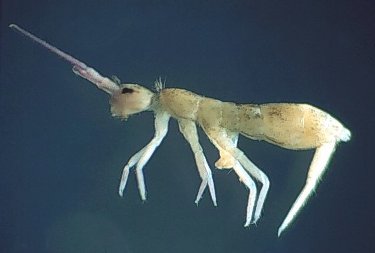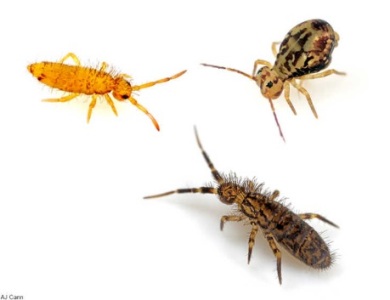Brought to you by ARBICO Organics

This cute, almost cartoon-like, creature is a common bug you’ve probably never even noticed. This is a Globular Springtail, one of the more than 8,000 species of springtails worldwide. Springtails come in a huge variety of shapes and colors and can live in soil or water, but they’re all no more than 1/8” in size (which would be a big one).
All springtails have a V-shaped appendage (the furcular) at the rear end of their bodies that gives them their name and allows them to jump. This body part works just like one of those little toy frogs that you push down and then let go and it pops up in the air. Springtails jump as an escape mechanism (no flying – they’re wingless), otherwise they just scurry around. They can’t control their jump, so their attempted escape can be rather chaotic, especially when there is a large group of them going off all at once. You can see them up close in this video.

Springtails are often misidentified as fleas. In fact, they’re sometimes called “snow fleas” because some species can and do live in snow. But, unlike fleas, they do not bite and pose no risk for humans. They are, in fact, are a valuable member of the soil microfauna. They feed on decaying organic matter in the soil, which releases minerals for your plants use. Their feeding keeps the soil and its microbial life healthy and thriving and the soil structure aerated, which provides pathways for water and nutrients to move through. In cases of extreme infestation in outdoor settings, they can begin to nibble on plant roots, but even that action may stimulate additional root branching and result in little to no damage. Remedial action against springtails should only be considered if there is a true swarm.

Springtails are damp-loving creatures, so if you see them, you can be sure there is a moisture source they are attracted to. If you see them in houseplants, you’ll know you’re overwatering and simply allowing the plants to dry out some should solve the problem (for more on springtails in houseplants, go here). If you are seeing them inside areas with easy access to outside, follow the trail to find moisture source. Look for damp landscaping material or soil beds along your outside wall. If you find them deeper in the house under sinks, by floorboards, or in the basement you could have a serious leakage problem in your walls or foundation. Once the dampness is removed from the equation, the springtails will quickly disappear as well. If you’ve tried everything and still don’t have a handle on the infestation situation, you can try sprinkling some Diatomaceous Earth on top of the soil or go the fire-vs-fire route and introduce a predatory insect that will feed on springtails. These two very enthusiastic predators will do the job – Rove Beetles and Stratiolaelaps scimitus (Hypoaspis miles).
Springtails are fascinating little creatures and there is a vibrant community of people out there who study and collect them. Within the astonishing variety of springtails in the world, some of them are quite beautiful. Check out this page full of dazzling examples. And then there is this man who combines exquisitely detailed macro-photography with years of study to provide totally entertaining information on these little bugs.
Pam Couture is the Lead Content Writer at ARBICO Organics. She lives in Tucson, Arizona, where she is surrounded by family, friends and nature. ARBICO Organics can be contacted at 800.827.2847 and you can visit their website at ARBICO-Organics.com.
Related Articles & Free Email Newsletter
Natural Mite and Pest Control Options for Your Orchids
Understanding Natural Pesticides


Comment here